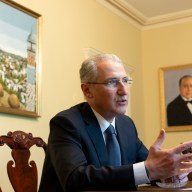COLOMBO, Sri Lanka – A mortar shell slammed into a crowd of wounded civilians waiting for treatment on Tuesday at the only medical facility left in Sri Lanka’s war zone, killing 49 people in the third day of intense shelling in the area, health officials said.
The Tamil Tiger rebels blamed the government for the attack – the second deadly strike on the hospital this month – and called on the international community to push for an immediate cease-fire.
Sri Lankan officials denied responsibility, saying they had ceased using artillery and mortars weeks ago.
But the UN humanitarian chief said there was evidence the government was still using heavy weapons, despite the estimated 50,000 civilians stuck in the tiny coastal strip still under rebel control.
The Red Cross said a ferry filled with aid had to turn back because of fighting.
Pressing ahead with the offensive, government forces broke through a sand fortification, killed dozens of insurgents and advanced to the edge of the “safe zone” where the government had told the civilians in the war zone to gather, military spokesman Brig. Udaya Nanayakkara said.
The attack Tuesday on the makeshift hospital’s admissions ward – little more than a tin roof and blue tarp walls – came after a weekend of artillery barrages that killed as many as 1,000 civilians, according to hospital officials.
While some of the victims of those earlier attacks waited to be treated, a single mortar shell hit the admissions ward at about 7:30 a.m., said Dr. Thurairaja Varatharajah, the top government health official in the war zone.
Just outside the admissions ward, bodies were strewn about in the dirt while health workers hooked up the wounded to intravenous lines, according to photographs taken after the attack.
Later, nearly two dozen dead bodies were lined up in rows in a sandy courtyard.
Other photographs showed civilians fleeing the area. One man, running away, was carrying a child with a bandaged head.
Shells were still falling hours later, including one that landed about 150 metres from the hospital, Varatharajah said.
Two other hospital officials, who spoke separately on condition of anonymity, confirmed the attack and said a hospital administrator was among those killed. All three health officials declined to say who had fired the shells.
The hospital had been hit by artillery May 2, in an attack that killed 64 civilians.
Rebel spokesman Seevaratnam Puleedevan blamed the new attack on the government and said civilians were fleeing in all directions inside the tiny war zone for a place to hide.
“There’s no place to seek shelter or protect themselves,” he said.
UN humanitarian chief John Holmes said the government was still using heavy weapons, though he did not say who was responsible for Tuesday’s attack.
“The government have said they are not using heavy weapons, but the evidence suggests that they are continuing to do so, at least to some extent, and that’s obviously contributing to the dreadful casualty figures that we’ve seen,” John Holmes said in Geneva.
He also accused the rebels of holding the civilians in the war zone as human shields.
Sri Lankan defence spokesman Keheliya Rambukwella denied the army had launched the attack and reiterated the government’s promise not to launch any airstrikes or artillery into the densely populated area.
Reports of the fighting are difficult to verify because the government bars journalists and aid workers from the war zone.
The violence was so intense that a Red Cross ferry sent to the area to bring in food aid and to evacuate the wounded was forced to turn around.
“There is fighting going on, and we need a more quiet environment to land,” said Paul Castella, the head of the Sri Lanka office for the International Committee of the Red Cross.
The rebels called on the international community to force the government to stop its offensive against the violent separatist group, which has been fighting for a homeland for the ethnic Tamil minority for more than a quarter century.
“We are really afraid that if the Sri Lankan government is not being pressured to stop the carnage, that many more civilians will die in the hundreds,” Puleedevan said.
UN figures compiled last month showed that nearly 6,500 civilians had been killed in three months this year as the government drove the separatist rebels from their northern strongholds and vowed to end the war.
–
Bharatha Mallawarachi contributed to this report from Colombo.














